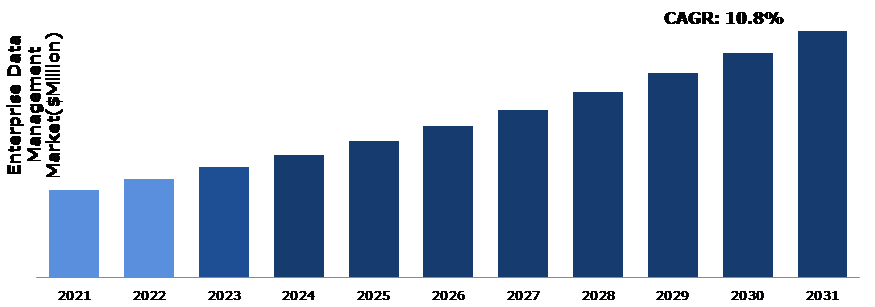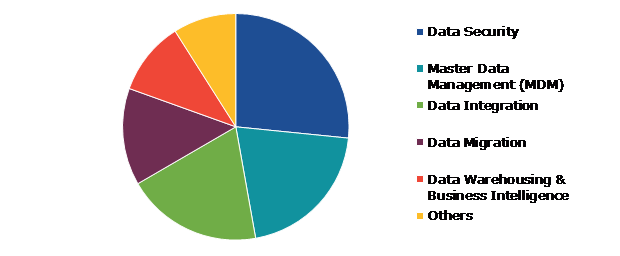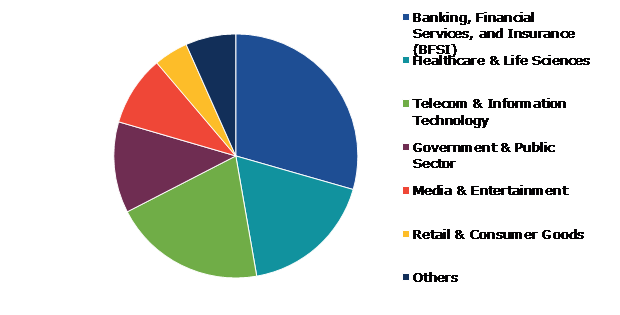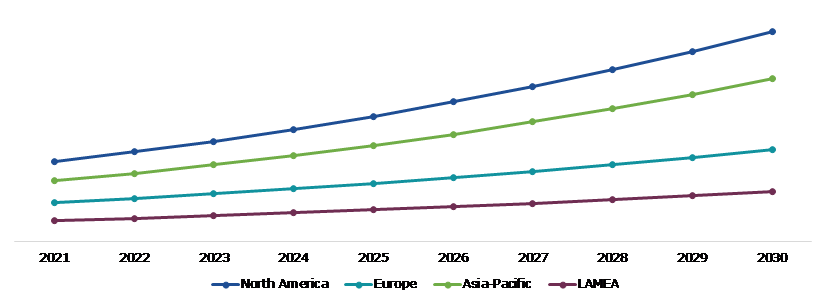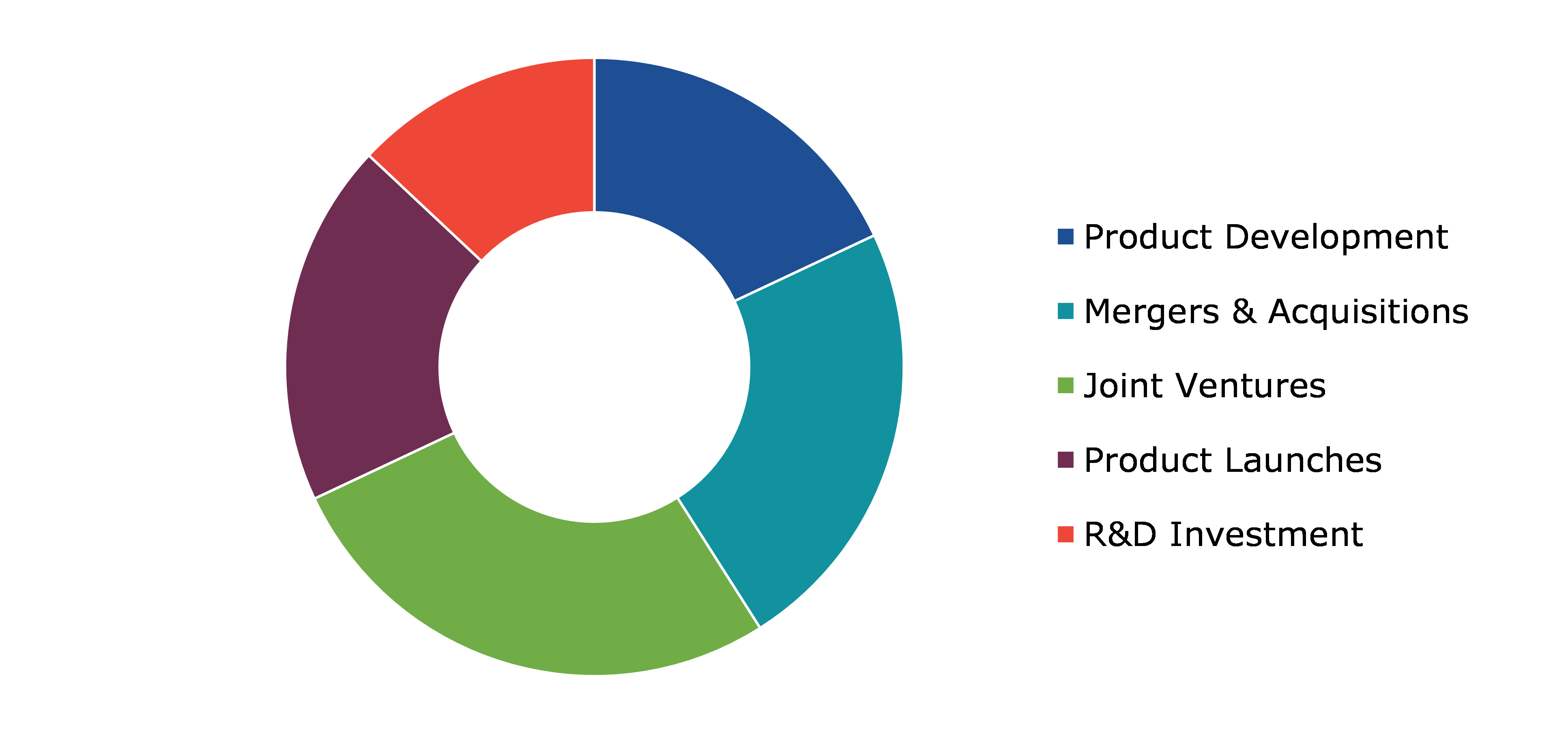Enterprise Data Management Market Report
RA00167
Enterprise Data Management Market by Component Type (Software and Services), Product Type (Data Security, Master Data Management(MDM), Data Integration, Data Migration, Data Warehousing & Business, and Others), Deployment Type (On-premises and Cloud), Organization Size (Large Enterprise and Small & Medium-sized Enterprises), End-use Industry (Healthcare, Banking, Financial Services, & Insurance sector (BFSI), Telecom & Information Technology, Retail & Consumer Goods, Media & Entertainment, Government & Defense, and Others), and Regional Outlook (North America, Europe, Asia-Pacific, and LAMEA): Global Opportunity Analysis and Industry Forecast, 2022-2031
Global Enterprise Data Management Market Analysis
The Global Enterprise Data Management Market Size was $79,733.8 million in 2021 and is predicted to grow with a CAGR of 10.8%, generating revenue of $224,520.1 million by 2031.
Global Enterprise Data Management Market Synopsis
The increased usage of data management applications in many organizations is expected to propel the enterprise data management market growth over the projected period. The demand for data management has expanded as a result of dealing with big data sets through data integration, data profiling, data quality checks, metadata management, and a variety of other data-related issues. Furthermore, corporate data management assists organizations in sharing, consistency, dependability, and managing information for critical choices, which is expected to be a significant driving force for the market.
However, during the projection timeframe, data privacy is expected to impede market growth. The majority of businesses handle data using open source software that contains diverse procedures and algorithms. As most procedures and algorithms are operated through open sources, hackers can easily obtain the source code if the data is not adequately safeguarded. These are the most significant market growth constraints in the predicted year.
Consumer demand for business data management is anticipated to grow as approaches facilitate the creation of a process for generating useful insights from unstructured or redundant data. It helps with data management between departments within a company. Demand for EDM solutions is expected to rise as organizations place a greater focus on ensuring timely and accurate information. During the forecast period, these factors are projected to fuel the growth of the global corporate enterprise data management market.
According to regional analysis, the Asia-Pacific region is expected to grow significantly in the coming years. As cloud computing gains popularity and the need to boost operational efficiency in large organizations and small & medium-sized (SMEs) enterprises grows, it is predicted that the demand for enterprise data management in Asia-Pacific will rise during the projected time.
Enterprise Data Management Overview
Enterprise data management enables the business to accurately define its capabilities, integrate quickly, and effectively retrieve the data for both internal and external communication. In contrast to many data streams, enterprise data management places a greater emphasis on the production of content in a consistent, accurate, and transparent manner. Enterprise data management includes the accurate and secure flow of data among partners.
COVID-19 Impact on Global Enterprise Data Management Market
The COVID-19 impact on enterprise data management market epidemic has resulted in a significant increase in the demand for EDM systems. This is mostly due to the fact that EDM systems can track vulnerable families and individuals by combining age and population estimates from school conscription, restricted tax information, and national paperwork. In addition, the EDM system uses cell phone data and geo-location information to track the travel patterns of COVID-19-infected individuals. EDM systems, for instance, have aided the Indian government and other government authorities in the identification, quarantining, and testing of various individuals who have had direct contact with the coronavirus-infected person. In the midst of an unprecedented crisis, these forces are fostering global market growth.
However, in July 2021, Informatica, introduced AI-powered cloud platform service “Intelligent Data Management Cloud” for APAC region. This strategic move enables to meet the businesses that are accelerating into digital transformation to provide flexibility and scalability
The enterprise data management market is expected to be driven by rising adoption of advanced data management tools across large and medium sized enterprises.
The primary factor expected to propel the growth of the corporate data management market is the rise in use of it by clients working in various end-use sectors. Enterprise data management is a popular choice among firms since it helps them oversee and monitor their operations while ensuring efficiency. Additionally, it is anticipated that during the course of the forecast period, the requirement for risk management will increase. The business manages its risk and maximizes database management prospects with the aid of risk management systems; as a result, the organization adopts enterprise data management to a considerable extent, which is anticipated to accelerate market expansion throughout the projected period.
To know more about global enterprise data management market drivers, get in touch with our analysts here.
The enterprise data management industry is anticipated to be most restricted by open source platforms.
The increase in accessibility and easy availability of open source solutions is predicted to be the biggest restraint for the enterprise data management market trend. Most of the platforms easily available through open sources are user friendly. However, these open source platforms are easy to hack for backend programmers, which can result in an easy data breach. Data breaches can be considered the biggest restraint on the enterprise data management market’s growth in the forecast period.
Increased adoption of cloud-based models by various enterprises will result in the creation of new opportunities
The global enterprise data management market is expected to profit from expansion opportunities given by cloud integration and data integration. Software integration is based on analytical models that govern massive volumes of data. Using cloud technology, it is feasible to monitor the need for data regulation in a secure setting at a fair cost. The incentives have pushed members to collaborate, boosting the market's size. Technologies that have emerged, such as AWS or an OpenStack data center, are focused on software that enables data integration and integrity inside public cloud platforms. With these positive qualities, the market is expected to have significant development potential throughout the assessment period.
To know more about global enterprise data management market opportunities, get in touch with our analysts here.
Global Enterprising Data Management Market, by Component Type
Based on component type, the market has been divided into software and services. Among these, the software sub-segment accounted for the highest market share in 2021, whereas the services sub-segment is estimated to show the fastest growth during the forecast period.
Global Enterprising Data Management Market Size, by Component Type, 2021
Source: Research Dive Analysis
The software sub-type holds major market share as a result of the increased solutions adoption among small and medium-sized enterprises (SMEs). To comply with legal requirements, especially those relating to data privacy and financial reporting, organizations are increasingly adopting efficient corporate data management solutions. The adoption of corporate data management systems is anticipated to be driven by the need to increase efficiency throughout the business by reducing duplicate and erroneous data.
The service sub-type is expected to showcase robust growth in the forecast period. The services will be able to assist businesses in streamlining their data and enhancing operational efficiency. Without sacrificing quality, they provide efficient features at low rates. Managed services provide assistance and make sure that the services provided for different business processes are consistent and reliable. Furthermore, they are capable of integrating and managing both traditional and cloud-based IT systems. It therefore augurs well for the expansion that businesses are increasingly depending on IT resources to boost productivity.
Global Enterprise Data Management Market, by Product Type
Based on product type, the market has been divided into data security, master data management (MDM), data integration, data migration, data warehousing & business, and others. Among these, the data security sub-segment accounted for the highest revenue share in 2021.
Global Enterprise Data Management Market Share, by Product Type, 2021
Source: Research Dive Analysis
The data security sub-segment generated highest revenue in 2021. Enterprise data protection is the delivery, management, and oversight of security across all data repositories and objects within a company. No matter where data is used or stored within the company, this wide term encompasses a number of tools, rules, strategies, and structures to assure its security. In a company, enterprise data protection largely establishes and oversees data security processes and standards. Data standards and procedures might change based on how they are used and how important information is. For instance, highly sensitive data can be protected by implementing encryption, limited access, and multi-factor authentication techniques.
Global Enterprise Data Management Market, by Deployment Type
Based on deployment type, the market has been divided into on-premises and cloud. Among these, the data security sub-segment accounted for the highest revenue share in 2021.
Global Enterprise Data Management Market Trends, by Deployment Type, 2021
Source: Research Dive Analysis
The on-premises sub-segment holds a dominant position in 2021. Control is one of the advantages of on-premises data warehouses. By deploying on-premises, an organization has total control over the hardware and software it uses, as well as where it is located and who has access to it. The hardware could be purpose-built servers or the same kinds of commodity servers and storage systems used for other applications. An IT staff has physical access to the hardware and access to every layer of software to assist in troubleshooting in the case of a failure. They can check the indicator lights, restart the power, or swap out the necessary components. They can restore the system's functionality without depending on outside parties.
Global Enterprise Data Management Market, by Organization Size
Based on organization size, the market has been divided into large enterprise and small & medium-sized enterprises. Among these, the large enterprise sub-segment accounted for the highest revenue share in 2021.
Global Enterprise Data Management Market Growth, by Organization Size, 2021
Source: Research Dive Analysis
The large enterprise sub-segment generated highest revenue in 2021. Large businesses are driven to implement business solutions by the high-tech tools needed for the associated processes and activities, including sophisticated analytical engines, process blueprints, and real-time data compilation tools. Large businesses put a lot of effort into implementing efficient data-driven ways to categorize and foresee potential dangers and use this information to make quicker business choices. It is projected that these elements will increase demand for EDM solutions.
Global Enterprise Data Management Market, by End-use Industry
Based on end-use industry, the market has been divided into The end-use industry segment is further classified into healthcare, BFSI, telecom & information technology, retail & consumer goods, media & entertainment, government & defense, and others. Among these, the BFSI sub-segment accounted for highest revenue share in 2021.
Global Enterprise Data Management Market Analysis, by End-use Industry, 2021
Source: Research Dive Analysis
The Banking, Financial Services, & Insurance Sector (BFSI) sub-segment holds market share in 2021. The banking, financial services, and insurance industries deal with an enormous amount of data on a daily basis. Daily information is logged to maintain a complete picture of the firm, including client information, financial transactions, and past purchases of goods and services. Therefore, handling enormous amounts of data offers these systems a tremendous chance to grow their businesses in the banking, financial services, and insurance sectors. It has been predicted that the banking, financial services, and insurance category will significantly enhance the total corporate data management market throughout the projection period.
Global Enterprise Data Management Market, Regional Insights
The enterprise data management market was investigated across North America, Europe, Asia-Pacific, and LAMEA.
Global Enterprise Data Management Market Size & Forecast, by Region, 2021-2031 (USD Million)
Source: Research Dive Analysis
The Market for Enterprise Data Management in North America to be the Most Dominant
The North American region generated highest revenue in 2021. The North American enterprise data management market analysis is driven by the region's fast-paced growth of small, medium, and large organizations. To prevent data loss, organizations have had to significantly advance proper data management due to the growth of several enterprises that generate vast volumes of data. As a result of this factor, the enterprise data management market share industry has grown. Throughout the anticipated period, regional market growth is anticipated to be fueled by large organizations’ rising demand for risk management solutions. Due to the numerous governments in the area encouraging software companies to build and develop free and open-source programs for controlling and enabling remote access to a massive amount of data, the demand for EDM solutions is anticipated to rise during the projected year.
Competitive Scenario in the Global Enterprise Data Management Market
Investment and agreement are common strategies followed by major market players. For instance, in February 2019, the IBM Cloud Integration platform was introduced by IBM Corporation. This platform offers hybrid cloud services to help companies migrate, integrate, and manage applications across on-premises and cloud environments, resulting in a 1/3 reduction in integration costs and times.
Source: Research Dive Analysis
Some of the leading enterprise data management players are NTT Communications Corporation, IBM Corporation, SAP SE, SAS Institute Inc., Cloudera, Inc., HP Development Company, L.P., Microsoft, TierPoint, LLC., VMware Inc., and Amazon Web Services, Inc.
| Aspect | Particulars |
| Historical Market Estimations | 2019-2020 |
| Base Year for Market Estimation | 2021 |
| Forecast Timeline for Market Projection | 2022-2030 |
| Geographical Scope | North America, Europe, Asia-Pacific, and LAMEA |
| Segmentation by Component Type |
|
| Segmentation by Product Type |
|
| Deployment Type |
|
| Organization Size |
|
| End-use Industry |
|
| Key Companies Profiled |
|
Q1. What is the size of the global enterprise data management system market?
A. The size of the global enterprise data management market share was over $ 79,733.8 million in 2021 and is projected to reach $224,520.1 million by 2031.
Q2. Which are the major companies in the enterprise data management system market?
A. Amazon Web Services, Inc., and SAP SE are some of the key players in the global enterprise data management market.
Q3. Which region, among others, possesses greater investment opportunities in the near future?
A. The Asia-Pacific region possesses great investment opportunities for investors to witness the most promising growth in the future.
Q4. What will be the growth rate of the Asia-Pacific enterprise data management system market?
A. Asia-Pacific enterprise data management market share is anticipated to grow at11.3%CAGR during the forecast period.
Q5. What are the strategies opted by the leading players in this market?
A. Product development is the key strategy opted by the operating companies in this market.
Q6. Which companies are investing more on R&D practices?
A. Amazon Web Services, Inc., is the company investing more in R&D activities for developing new products and technologies.
1.Research Methodology
1.1.Desk Research
1.2.Real time insights and validation
1.3.Forecast model
1.4.Assumptions and forecast parameters
1.5.Market size estimation
1.5.1.Top-down approach
1.5.2.Bottom-up approach
2.Report Scope
2.1.Market definition
2.2.Key objectives of the study
2.3.Report overview
2.4.Market segmentation
2.5.Overview of the impact of COVID-19 on Global enterprise data management market
3.Executive Summary
4.Market Overview
4.1.Introduction
4.2.Growth impact forces
4.2.1.Drivers
4.2.2.Restraints
4.2.3.Opportunities
4.3.Market value chain analysis
4.3.1.List of raw material suppliers
4.3.2.List of manufacturers
4.3.3.List of distributors
4.4.Innovation & sustainability matrices
4.4.1.Technology matrix
4.4.2.Regulatory matrix
4.5.Porter’s five forces analysis
4.5.1.Bargaining power of suppliers
4.5.2.Bargaining power of consumers
4.5.3.Threat of substitutes
4.5.4.Threat of new entrants
4.5.5.Competitive rivalry intensity
4.6.PESTLE analysis
4.6.1.Political
4.6.2.Economical
4.6.3.Social
4.6.4.Technological
4.6.5.Environmental
4.7.Impact of COVID-19 on enterprise data management market
4.7.1.Pre-covid market scenario
4.7.2.Post-covid market scenario
5.Enterprise Data Management Market, by Component Type
5.1.Overview
5.1.1.Market size and forecast, by Component Type
5.2.Software
5.2.1.Key market trends, growth factors, and opportunities
5.2.2.Market size and forecast, by region, 2021-2031
5.2.3.Market share analysis, by country 2021 & 2031
5.3.Service
5.3.1.Key market trends, growth factors, and opportunities
5.3.2.Market size and forecast, by region, 2021-2031
5.3.3.Market share analysis, by country 2021 & 2031
5.4.Research Dive Exclusive Insights
5.4.1.Market attractiveness
5.4.2.Competition heatmap
6.Enterprise Data Management Market, by Product Type
6.1.Overview
6.1.1.Market size and forecast, by Product Type
6.2.Data Security
6.2.1.Key market trends, growth factors, and opportunities
6.2.2.Market size and forecast, by region, 2021-2031
6.2.3.Market share analysis, by country 2021 & 2031
6.3.Master Data Management (MDM)
6.3.1.Key market trends, growth factors, and opportunities
6.3.2.Market size and forecast, by region, 2021-2031
6.3.3.Market share analysis, by country 2021 & 2031
6.4.Data Integration
6.4.1.Key market trends, growth factors, and opportunities
6.4.2.Market size and forecast, by region, 2021-2031
6.4.3.Market share analysis, by country 2021 & 2031
6.5.Data Migration
6.5.1.Key market trends, growth factors, and opportunities
6.5.2.Market size and forecast, by region, 2021-2031
6.5.3.Market share analysis, by country 2021 & 2031
6.6.Data Warehousing & Business Intelligence
6.6.1.Key market trends, growth factors, and opportunities
6.6.2.Market size and forecast, by region, 2021-2031
6.6.3.Market share analysis, by country 2021 & 2031
6.7.Others
6.7.1.Key market trends, growth factors, and opportunities
6.7.2.Market size and forecast, by region, 2021-2031
6.7.3.Market share analysis, by country 2021 & 2031
6.8.Research Dive Exclusive Insights
6.8.1.Market attractiveness
6.8.2.Competition heatmap
7.Enterprise Data Management Market, by Deployment Type
7.1.Overview
7.1.1.Market size and forecast, by Deployment Type
7.2.On-premises
7.2.1.Key market trends, growth factors, and opportunities
7.2.2.Market size and forecast, by region, 2021-2031
7.2.3.Market share analysis, by country 2021 & 2031
7.3.Cloud
7.3.1.Key market trends, growth factors, and opportunities
7.3.2.Market size and forecast, by region, 2021-2031
7.3.3.Market share analysis, by country 2021 & 2031
7.4.Research Dive Exclusive Insights
7.4.1.Market attractiveness
7.4.2.Competition heatmap
8.Enterprise Data Management Market, by Organization Size
8.1.Overview
8.1.1.Market size and forecast, by Organization Size
8.2.Large Enterprise
8.2.1.Key market trends, growth factors, and opportunities
8.2.2.Market size and forecast, by region, 2021-2031
8.2.3.Market share analysis, by country 2021 & 2031
8.3.Small and Medium-Sized Enterprises
8.3.1.Key market trends, growth factors, and opportunities
8.3.2.Market size and forecast, by region, 2021-2031
8.3.3.Market share analysis, by country 2021 & 2031
8.4.Research Dive Exclusive Insights
8.4.1.Market attractiveness
8.4.2.Competition heatmap
9.Enterprise Data Management Market, by End-use Industry
9.1.Overview
9.1.1.Market size and forecast, by End-use Industry
9.2.Banking, Financial Services, and Insurance (BFSI)
9.2.1.Key market trends, growth factors, and opportunities
9.2.2.Market size and forecast, by region, 2021-2031
9.2.3.Market share analysis, by country 2021 & 2031
9.3.Healthcare & Life Sciences
9.3.1.Key market trends, growth factors, and opportunities
9.3.2.Market size and forecast, by region, 2021-2031
9.3.3.Market share analysis, by country 2021 & 2031
9.4.Telecom & Information Technology
9.4.1.Key market trends, growth factors, and opportunities
9.4.2.Market size and forecast, by region, 2021-2031
9.4.3.Market share analysis, by country 2021 & 2031
9.5.Government & Public Sector
9.5.1.Key market trends, growth factors, and opportunities
9.5.2.Market size and forecast, by region, 2021-2031
9.5.3.Market share analysis, by country 2021 & 2031
9.6.Media & Entertainment
9.6.1.Key market trends, growth factors, and opportunities
9.6.2.Market size and forecast, by region, 2021-2031
9.6.3.Market share analysis, by country 2021 & 2031
9.7.Retail & Consumer Goods
9.7.1.Key market trends, growth factors, and opportunities
9.7.2.Market size and forecast, by region, 2021-2031
9.7.3.Market share analysis, by country 2021 & 2031
9.8.Others
9.8.1.Key market trends, growth factors, and opportunities
9.8.2.Market size and forecast, by region, 2021-2031
9.8.3.Market share analysis, by country 2021 & 2031
9.9.Research Dive Exclusive Insights
9.9.1.Market attractiveness
9.9.2.Competition heatmap
10.Enterprise Data Management Market, by Region
10.1.North America
10.1.1.U.S.
10.1.1.1.Market size analysis, by Component Type
10.1.1.2.Market size analysis, by Product Type
10.1.1.3.Market size analysis, by Deployment Type
10.1.1.4.Market size analysis, by Organization Size
10.1.1.5.Market size analysis, by End-use Industry
10.1.2.Canada
10.1.2.1.Market size analysis, by Component Type
10.1.2.2.Market size analysis, by Product Type
10.1.2.3.Market size analysis, by Deployment Type
10.1.2.4.Market size analysis, by Organization Size
10.1.2.5.Market size analysis, by End-use Industry
10.1.3.Mexico
10.1.3.1.Market size analysis, by Component Type
10.1.3.2.Market size analysis, by Product Type
10.1.3.3.Market size analysis, by Deployment Type
10.1.3.4.Market size analysis, by Organization Size
10.1.3.5.Market size analysis, by End-use Industry
10.1.4.Research Dive Exclusive Insights
10.1.4.1.Market attractiveness
10.1.4.2.Competition heatmap
10.2.Europe
10.2.1.Germany
10.2.1.1.Market size analysis, by Component Type
10.2.1.2.Market size analysis, by Product Type
10.2.1.3.Market size analysis, by Deployment Type
10.2.1.4.Market size analysis, by Organization Size
10.2.1.5.Market size analysis, by End-use Industry
10.2.2.UK
10.2.2.1.Market size analysis, by Component Type
10.2.2.2.Market size analysis, by Product Type
10.2.2.3.Market size analysis, by Deployment Type
10.2.2.4.Market size analysis, by Organization Size
10.2.2.5.Market size analysis, by End-use Industry
10.2.3.France
10.2.3.1.Market size analysis, by Component Type
10.2.3.2.Market size analysis, by Product Type
10.2.3.3.Market size analysis, by Deployment Type
10.2.3.4.Market size analysis, by Organization Size
10.2.3.5.Market size analysis, by End-use Industry
10.2.4.Spain
10.2.4.1.Market size analysis, by Component Type
10.2.4.2.Market size analysis, by Product Type
10.2.4.3.Market size analysis, by Deployment Type
10.2.4.4.Market size analysis, by Organization Size
10.2.4.5.Market size analysis, by End-use Industry
10.2.5.Italy
10.2.5.1.Market size analysis, by Component Type
10.2.5.2.Market size analysis, by Product Type
10.2.5.3.Market size analysis, by Deployment Type
10.2.5.4.Market size analysis, by Organization Size
10.2.5.5.Market size analysis, by End-use Industry
10.2.6.Rest of Europe
10.2.6.1.Market size analysis, by Component Type
10.2.6.2.Market size analysis, by Product Type
10.2.6.3.Market size analysis, by Deployment Type
10.2.6.4.Market size analysis, by Organization Size
10.2.6.5.Market size analysis, by End-use Industry
10.2.7.Research Dive Exclusive Insights
10.2.7.1.Market attractiveness
10.2.7.2.Competition heatmap
10.3.Asia-Pacific
10.3.1.China
10.3.1.1.Market size analysis, by Component Type
10.3.1.2.Market size analysis, by Product Type
10.3.1.3.Market size analysis, by Deployment Type
10.3.1.4.Market size analysis, by Organization Size
10.3.1.5.Market size analysis, by End-use Industry
10.3.2.Japan
10.3.2.1.Market size analysis, by Component Type
10.3.2.2.Market size analysis, by Product Type
10.3.2.3.Market size analysis, by Deployment Type
10.3.2.4.Market size analysis, by Organization Size
10.3.2.5.Market size analysis, by End-use Industry
10.3.3.India
10.3.3.1.Market size analysis, by Component Type
10.3.3.2.Market size analysis, by Product Type
10.3.3.3.Market size analysis, by Deployment Type
10.3.3.4.Market size analysis, by Organization Size
10.3.3.5.Market size analysis, by End-use Industry
10.3.4.Australia
10.3.4.1.Market size analysis, by Component Type
10.3.4.2.Market size analysis, by Product Type
10.3.4.3.Market size analysis, by Deployment Type
10.3.4.4.Market size analysis, by Organization Size
10.3.4.5.Market size analysis, by End-use Industry
10.3.5.South Korea
10.3.5.1.Market size analysis, by Component Type
10.3.5.2.Market size analysis, by Product Type
10.3.5.3.Market size analysis, by Deployment Type
10.3.5.4.Market size analysis, by Organization Size
10.3.5.5.Market size analysis, by End-use Industry
10.3.6.Rest of Asia-Pacific
10.3.6.1.Market size analysis, by Component Type
10.3.6.2.Market size analysis, by Product Type
10.3.6.3.Market size analysis, by Deployment Type
10.3.6.4.Market size analysis, by Organization Size
10.3.6.5.Market size analysis, by End-use Industry
10.3.7.Research Dive Exclusive Insights
10.3.7.1.Market attractiveness
10.3.7.2.Competition heatmap
10.4.LAMEA
10.4.1.Brazil
10.4.1.1.Market size analysis, by Component Type
10.4.1.2.Market size analysis, by Product Type
10.4.1.3.Market size analysis, by Deployment Type
10.4.1.4.Market size analysis, by Organization Size
10.4.1.5.Market size analysis, by End-use Industry
10.4.2.Saudi Arabia
10.4.2.1.Market size analysis, by Component Type
10.4.2.2.Market size analysis, by Product Type
10.4.2.3.Market size analysis, by Deployment Type
10.4.2.4.Market size analysis, by Organization Size
10.4.2.5.Market size analysis, by End-use Industry
10.4.3.UAE
10.4.3.1.Market size analysis, by Component Type
10.4.3.2.Market size analysis, by Product Type
10.4.3.3.Market size analysis, by Deployment Type
10.4.3.4.Market size analysis, by Organization Size
10.4.3.5.Market size analysis, by End-use Industry
10.4.4.South Africa
10.4.4.1.Market size analysis, by Component Type
10.4.4.2.Market size analysis, by Product Type
10.4.4.3.Market size analysis, by Deployment Type
10.4.4.4.Market size analysis, by Organization Size
10.4.4.5.Market size analysis, by End-use Industry
10.4.5.Rest of LAMEA
10.4.5.1.Market size analysis, by Component Type
10.4.5.2.Market size analysis, by Product Type
10.4.5.3.Market size analysis, by Deployment Type
10.4.5.4.Market size analysis, by Organization Size
10.4.5.5.Market size analysis, by End-use Industry
10.4.6.Research Dive Exclusive Insights
10.4.6.1.Market attractiveness
10.4.6.2.Competition heatmap
11.Competitive Landscape
11.1.Top winning strategies, 2021
11.1.1.By strategy
11.1.2.By year
11.2.Strategic overview
11.3.Market share analysis, 2021
12.Company Profiles
12.1.NTT Communications Corporation
12.1.1.Overview
12.1.2.Business segments
12.1.3.Product portfolio
12.1.4.Financial performance
12.1.5.Recent developments
12.1.6.SWOT analysis
12.2.IBM Corporation
12.2.1.Overview
12.2.2.Business segments
12.2.3.Product portfolio
12.2.4.Financial performance
12.2.5.Recent developments
12.2.6.SWOT analysis
12.3.SAP SE
12.3.1.Overview
12.3.2.Business segments
12.3.3.Product portfolio
12.3.4.Financial performance
12.3.5.Recent developments
12.3.6.SWOT analysis
12.4.SAS Institute Inc.
12.4.1.Overview
12.4.2.Business segments
12.4.3.Product portfolio
12.4.4.Financial performance
12.4.5.Recent developments
12.4.6.SWOT analysis
12.5.Cloudera, Inc.
12.5.1.Overview
12.5.2.Business segments
12.5.3.Product portfolio
12.5.4.Financial performance
12.5.5.Recent developments
12.5.6.SWOT analysis
12.6.HP Development Company, L.P.,
12.6.1.Overview
12.6.2.Business segments
12.6.3.Product portfolio
12.6.4.Financial performance
12.6.5.Recent developments
12.6.6.SWOT analysis
12.7.Microsoft
12.7.1.Overview
12.7.2.Business segments
12.7.3.Product portfolio
12.7.4.Financial performance
12.7.5.Recent developments
12.7.6.SWOT analysis
12.8.TierPoint, LLC.
12.8.1.Overview
12.8.2.Business segments
12.8.3.Product portfolio
12.8.4.Financial performance
12.8.5.Recent developments
12.8.6.SWOT analysis
12.9.VMware Inc.,
12.9.1.Overview
12.9.2.Business segments
12.9.3.Product portfolio
12.9.4.Financial performance
12.9.5.Recent developments
12.9.6.SWOT analysis
12.10.Amazon Web Services, Inc.,
12.10.1.Overview
12.10.2.Business segments
12.10.3.Product portfolio
12.10.4.Financial performance
12.10.5.Recent developments
12.10.6.SWOT analysis
13.Appendix
13.1.Parent & peer market analysis
13.2.Premium insights from industry experts
13.3.Related reports
In today’s fast-paced and data-driven business landscape, managing massive amounts of data has become a critical challenge for enterprises of all sizes. From customer data to financial transactions, companies need to store, organize, and analyze data in real-time to stay competitive and make informed decisions. This is where the enterprise data management (EDM) solution comes in.
EDM solutions help businesses to leverage the power of their data. These solutions provide a comprehensive framework for managing all aspects of enterprise data, from governance and quality assurance to analytics and insights. In this era of digital transformation, the enterprise data management market is at the forefront of helping organizations make sense of their data and turn it into a strategic asset that drives business growth and innovation.
Recent Trends in the Enterprise Data Management Market
The enterprise data management market is continuously evolving with new technologies and practices. One of the significant trends that have emerged in the enterprise data management industry is a surge in cloud-based solutions that offer scalability and cost-effectiveness. AI and Machine Learning (ML) are being integrated into EDM solutions to automate data analysis and decision-making processes. Additionally, data governance and compliance, data democratization, and data quality management have become important trends in the enterprise data management market, as enterprises prioritize data-driven decision making and maintaining high-quality data.
Newest Insights in the Enterprise Data Management Market
As per a report by Research Dive, the global enterprise data management market is expected to grow at a CAGR of 10.8% and generate revenue of $224,520.1 million by 2031. The primary factors driving the growth of the market are the increased usage of data management applications in many organizations and the demand for data management due to the need for dealing with big data sets through data integration, data profiling, data quality checks, metadata management, and other data-related issues. However, data privacy concerns related to EDM solutions are expected to hinder the market growth.
The enterprise data management market in the North America region is expected to remain dominant in the coming years. The region’s high revenue in 2021 was driven by the fast-paced growth of small, medium, and large organizations in this region, which generate vast volumes of data. This has led to an increased need for proper data management to prevent data loss and enhance data security.
How are Market Players Responding to the Rising Demand for Enterprise Data Management?
Market players are responding to the rising demand for enterprise data management by investing in research and development to create more advanced and efficient data management solutions. They are also expanding their product portfolios to include a wide range of data management tools and services that cater to the unique needs of different industries and organizations.
In addition, market players are increasingly focusing on strategic partnerships and collaborations with other players in the industry to leverage their strengths and expand their reach. Some of the foremost players in the enterprise data management market are Microsoft, NTT Communications Corporation, SAP SE, Amazon Web Services, Inc., IBM Corporation, SAS Institute Inc., VMware Inc., Cloudera, Inc., HP Development Company, L.P., TierPoint, LLC., and others. These players are focused on implementing strategies such as mergers and acquisitions, novel developments, collaborations, and partnerships to reach a leading position in the global market. For instance:
- In June 2022, Informatica, a leading enterprise cloud data management company, announced the launch of its new enterprise data integrator. The integrator is designed to streamline data integration and management for organizations of all sizes, with advanced data governance capabilities for the Snowflake data cloud.
- In September 2022, Schlumberger, a foremost provider of technology for reservoir characterization, production, drilling, and processing to the oil & gas industry, announced the launch of its latest product - the Schlumberger Enterprise Data Solution. The solution is powered by Microsoft Energy Data Services and has been developed to meet the emerging necessities of the OSDU™ Technical Standard, a novel open industry standard for energy data.
- In November 2022, Amazon Web Services (AWS), a leading provider of reliable, scalable, and inexpensive cloud computing services, unveiled a new data management service called Amazon DataZone. This innovative solution will enable enterprises to effectively catalog, discover, share, and govern their data.
COVID-19 Impact on the Global Enterprise Data Management Market
The COVID-19 pandemic created an unprecedented crisis, and enterprise data management systems greatly helped to mitigate the effects by fostering the global market growth. The pandemic has led to a significant increase in the demand for EDM systems, and as a result, the enterprise data management market is expected to witness substantial growth in the coming years. With the help of enterprise data management systems, vulnerable individuals and families were tracked and provided with the necessary support. Additionally, enterprise data management systems were used to track the travel patterns of COVID-19-infected individuals, making it easier for authorities to identify and quarantine them, thus reducing the spread of the virus.
Personalize this research
- Triangulate with your own data
- Request your format and definition
- Get a deeper dive on a specific application, geography, customer or competitor
- + 1-888-961-4454 Toll - Free
- support@researchdive.com

